Exploring the great outdoors in bear country can be an extraordinary experience, offering a unique opportunity to connect with nature. However, it’s essential to remember that this adventure comes with the responsibility of ensuring personal safety and respecting the natural habitat of the bears. This comprehensive guide provides you with fifteen crucial tips for camping safely in bear country, covering everything from preparing for your trip to dealing with potential bear encounters. Whether you’re a seasoned camper or a first-time adventurer, these tips will help you navigate the wilderness responsibly and enjoy your journey with peace of mind.
1. Educate Yourself About Bears
Before venturing into bear country, gaining a thorough understanding of bear behavior, species differences, and their natural habitats is crucial. This knowledge not only enhances your camping experience but also significantly increases your safety.
Understanding Bear Behavior
Bears, primarily black and grizzly bears in North America, have distinct behaviors. Black bears are generally less aggressive and more adaptable to human presence, whereas grizzlies are more territorial and can be aggressive if surprised or if they feel their cubs are threatened. Familiarizing yourself with bear behavior patterns, such as foraging habits, reactions to humans, and maternal behavior, is essential.
Identifying Bear Species
Learning to differentiate between bear species is vital. Black bears have smaller, more pointed ears, shorter claws, and a straighter facial profile. In contrast, grizzly bears have larger, rounder ears, long claws, and a pronounced shoulder hump. Knowing these differences can inform how you react during an encounter.
Bear Habitats
Bears are commonly found in forested areas with abundant food sources. Understanding their habitats helps in choosing safer campsite locations and recognizing signs of bear activity.
Experts’ Advice
Renowned bear biologist Dr. Lynn Rogers, known for his extensive work with black bears, emphasizes the importance of calm behavior during bear encounters. “Bears are as afraid of us as we are of them. Yelling or throwing something may provoke an attack,” he cautions. This advice aligns with the National Park Service’s guidelines on bear encounters.
Respecting Bear Territory
Acknowledging that you are in bear territory and respecting their space is crucial. According to Tom Smith, a bear researcher, “Bears are not out to get you. They usually want to avoid humans. Give them space and an escape route.”
Sources for Further Learning
- Books: “Bear Attacks: Their Causes and Avoidance” by Stephen Herrero offers an in-depth analysis of bear behavior and attack prevention.
- Online Resources: Websites like BearSmart.com provide comprehensive information on living and camping safely in bear country.
- Park Ranger Talks: Attend talks by park rangers in national parks known for bear populations. They often share valuable, location-specific information.
Being educated about bears is the foundation of safe camping in their habitat. It fosters a respectful coexistence and enriches your outdoor experience. As wildlife biologist John Hechtel notes, “Understanding bears is the key to appreciating them in their natural habitat without fear.” This knowledge is your first and most crucial line of defense in bear country.
2. Proper Trip Planning
Proper trip planning is the foundation of a safe and enjoyable camping experience in bear country. This tip emphasizes the importance of thorough preparation before embarking on your outdoor adventure. It encompasses everything from selecting the right campsite to understanding and adhering to local wildlife regulations. By meticulously planning your trip, you not only ensure your own safety but also respect the natural habitat of the bears. This approach is crucial for a harmonious coexistence with these majestic creatures and for preserving the integrity of the wilderness you’re exploring.
Selecting a Campsite
When choosing a campsite in bear country, avoid areas with dense vegetation, as bears use these for cover. Opt for open spaces, and if in grizzly country, consider camping near an escape tree and in designated safe camping grounds with electric bear fences.
Sleeping Arrangements
Sleeping in a tent is safer than sleeping under the stars. Maintain a gap between you and the tent wall to avoid potential bear bites or claws. Keep bear spray and a flashlight within reach.
Camp Organization
Separate your sleeping, cooking, washing, and food-storage areas by at least 100 meters. Total cleanliness is vital to avoid attracting bears. Plan meal quantities to avoid leftovers and store any remains securely.
Food Storage
Store all food and scented items in bear-resistant containers. Keep these containers at least 100 meters from your camp. Bear-resistant containers are effective only when properly closed and locked.
Injury Prevention and Response
Mentally prepare for how to avoid and respond to injuries. Carry a first-aid kit and means of communication, such as a mobile or satellite phone. In remote areas, these could be life-saving. Groups, especially those with four or more people, can deter bears and assist with injury response.
3. Safe Food Storage
In the realm of camping in bear country, the way you store your food plays a pivotal role in ensuring your safety and that of the wildlife. Safe food storage is not just a recommendation but a necessity to prevent attracting bears to your campsite. This tip focuses on effective strategies and best practices for storing food, cooking utensils, and any scented items that might pique a bear’s interest. From using bear-resistant containers to the proper way of hanging food, these guidelines are designed to minimize the chances of bear encounters and maintain the delicate balance between enjoying the wilderness and preserving its natural inhabitants.
Use Bear-resistant Containers: Store all food, beverages, and scented items in bear-resistant containers. These containers should be locked and placed away from your sleeping area.
- Hanging Food: If bear-resistant containers are not available, hang your food at least 10 feet above the ground and 4 feet away from the tree trunk. Ensure the hanging spot is at least 100 yards away from your sleeping area.
- Avoid Smelly Foods: Strong-smelling foods can attract bears from a great distance. Opt for foods that have less odor.
- Cleanliness with Cooking Utensils: Wash cooking utensils immediately after use. Store them with your food, away from your tent.
- Managing Leftovers: Avoid leftovers as much as possible. If you have leftovers, store them securely with your food. Never leave leftovers out in the open.
- Disposing of Garbage: All garbage should be packed out or disposed of in bear-proof garbage bins. Do not burn or bury waste as bears can still be attracted to the residual smells.
- Minimize Food Odors on Clothing and Gear: Avoid cooking in clothes that you sleep in. Store these clothes with your food if they have absorbed food odors.
- Food in Vehicles: If camping near a vehicle, use it to store your food only if it’s a hard-sided vehicle. Bears can break into soft-sided vehicles.

Each of these practices is designed to minimize the chances of a bear being attracted to your campsite, ensuring both your safety and the well-being of the bears.
4. Setting Up Camp Safely
Setting up camp safely in bear country requires thoughtful consideration and strategic planning. The location and arrangement of your campsite can significantly impact your safety and the likelihood of encountering bears. In bear habitats, where the line between human recreation and wildlife territory blurs, every decision—from where you pitch your tent to how you manage your cooking area—matters. This tip will delve into practical strategies for establishing a safe campsite, focusing on location, distance from food sources, and other key factors to minimize the risk of attracting bears and ensuring a secure camping environment.
- Choose the Right Location: Select a campsite away from bear paths, such as trails, streambeds, or dense brush. Look for signs of recent bear activity like tracks or scat and avoid those areas.
- Maintain Distance from Food Storage: Set up your tent at least 100 yards away from your cooking area and food storage site. This helps in keeping bears away from your sleeping area.
- Avoid Camping Near Water Sources: Bears often travel along rivers and streams, so camping at a distance from these water sources can reduce the likelihood of encounters.
- Be Mindful of Wind Direction: When setting up your cooking area, consider the wind direction. Cook downwind from your sleeping area to prevent food odors from drifting towards it.
- Keep a Clean Campsite: Ensure that your campsite is free of food scraps and garbage. Bears have a strong sense of smell and can be attracted to even the smallest food sources.
- Store Toiletries Safely: Store all toiletries, along with your food, in bear-resistant containers or hang them properly, as their scents can also attract bears.
- Use Natural Barriers: If possible, utilize natural barriers like rock outcroppings or large trees for added protection and to limit bear access routes to your camp.
- Prepare for Night: Have bear spray and a flashlight readily accessible in your tent at night. Familiarize yourself with the layout of your campsite in case you need to navigate it in the dark.
5. Bear Safety Gear
When camping in bear country, having the right safety gear is as important as being aware of your surroundings. While the chances of a bear encounter are typically low, being prepared can significantly increase your safety and peace of mind. The key is to have tools that can help deter bears and manage any encounters effectively. This tip will guide you through essential bear safety gear, each designed to enhance your protection in bear habitats. From bear spray to noise-making devices, understanding and carrying the right gear can make all the difference in ensuring a safe and enjoyable camping experience.
Bear Spray: Carry bear spray and know how to use it. It should be readily accessible, not buried in your backpack.
- Bear Bells and Noise Makers: While their effectiveness is debated, carrying bear bells or other noise-making devices can alert bears to your presence, potentially avoiding surprise encounters.
- Air Horns: An air horn can be used to scare off bears from a distance.
- Bear-Resistant Containers: Use bear-resistant containers for food and scented item storage, ensuring bears cannot access these items.
- Bear Fences: In some extreme cases, portable electric bear fences can be used around your campsite for added protection.
- Flashlights or Headlamps: Essential for nighttime visibility, these can also be used to deter curious bears.
- Whistles: A loud whistle can be an effective tool to scare off bears in close encounters.
- Safety Flares: In emergencies, safety flares can be used to scare bears away, especially useful in remote areas where help is far away.
Each piece of gear serves as a layer of protection or deterrence against potential bear encounters, contributing to a safer camping experience.
6. Cooking and Eating Guidelines
When camping in bear country, how and where you cook and eat can significantly impact your safety. These activities, by their nature, involve food odors and residues, which can attract bears. Therefore, it’s essential to follow specific guidelines to minimize risks. This tip covers crucial practices for cooking and eating while camping amidst bears. It focuses on strategies such as choosing the right location for your kitchen area, managing food odors, and disposing of waste properly. These measures are vital to reduce the likelihood of attracting bears to your campsite, ensuring both your safety and the bears’ well-being.
Cooking Location: Set up your cooking area at least 100 yards from your sleeping area. Choose a spot downwind from your tent to ensure food odors drift away from where you sleep.
- Eating Practices: Avoid eating in or near your tent. Consume food in your designated cooking area.
- Storing Cooking Equipment: Store stoves, grills, utensils, and any other cooking equipment with your food supply, away from your tent, to avoid attracting bears with residual scents.
- Minimize Odors: Use less aromatic food options and avoid strong-smelling substances like flavored cooking oils. Seal food in airtight containers.
- Waste Management: Dispose of all food waste properly. Strain food particles from dishwater and pack them out with your garbage. Scatter strained dishwater at least 100 yards from your campsite.
- Leftover Food: Store leftovers securely with your food supplies. If bear-proof containers are not available, hang leftovers along with your food supply.
- Cleanliness: Keep your cooking and eating areas scrupulously clean. Wipe down surfaces and wash dishes immediately after use.
By following these guidelines, you can significantly reduce the chances of a bear being attracted to your campsite due to cooking and eating activities.
7. Hiking Safety Practices
Exploring the wilderness in bear country requires vigilant hiking practices. This tip focuses on essential measures to ensure safety while hiking, such as making noise, choosing the right time to hike, and group dynamics. These practices are designed to prevent surprising bears and to increase your visibility in their habitat.
- Make Noise: Regularly make noise to alert bears of your presence. This can be done by talking loudly, clapping hands, or singing. Noise is crucial in dense forests or near streams where visibility is low.
- Avoid Dawn, Dusk, and Night Hikes: These times are when bears are most active. Plan your hikes during daylight hours.
- Hike in Groups: Bears are less likely to approach larger groups. Stay close together and keep children near.
- Stay Alert: Continuously watch for signs of bears, such as tracks, scat, or overturned rocks. Avoid using headphones that can impair your ability to hear surrounding noises.
Bear Scat Along Trail in Yosemite National Park - Carry Bear Spray: Ensure everyone in the group has easy access to bear spray and knows how to use it.
- Avoid Surprising Bears: On windy days or when walking near loud streams, increase your noise level to ensure you’re heard by bears.
- Respect Wildlife: If you see a bear, keep your distance. Never approach, feed, or attempt to interact with them.
By adopting these hiking safety practices, you can significantly reduce the risk of an unexpected bear encounter and ensure a safer wilderness experience.
8. Encountering a Bear
Encountering a bear can be an intense experience, but knowing how to react is key. This tip provides guidelines on how to behave if you come across a bear, including body language, communication, and escape strategies.
- Stay Calm and Assess the Situation: If you encounter a bear, remain calm and quickly assess whether the bear has noticed you and its behavior.
- Do Not Run: Running can trigger a bear’s predatory instinct. Instead, slowly back away while facing the bear. Plus bears are very fast runners.
- Speak Calmly: Talk to the bear in a calm, firm voice. Let the bear know you are human and not a prey animal.
- Make Yourself Look Big: Stand tall, raise your arms or a jacket above your head to appear larger.
- Give the Bear Space: If the bear is stationary, move away slowly and sideways; this allows you to keep an eye on the bear and avoid tripping.
- Do Not Block the Bear’s Escape Route: Make sure the bear has a clear path to leave.
- Avoid Eye Contact: Bears may perceive direct eye contact as a threat or challenge.
- Know the Bear Species: Your response can vary depending on whether it’s a black bear or a grizzly. With black bears, you may try to scare them off. With grizzlies, it’s often better to be passive.
- If the Bear Approaches: If a bear follows you or approaches, stand your ground. Make loud noises, bang objects together, or use bear spray if it continues to advance.
- If Attacked: In the rare event of an attack, your response should depend on the type of bear. Play dead with grizzlies, lying flat on your stomach with hands laced behind your neck. If it’s a black bear, try to escape or fight back focusing on the bear’s face and muzzle.
By understanding these guidelines and responding appropriately during a bear encounter, you can increase your chances of a safe resolution.
9. In Case of a Bear Attack
Bear attacks are rare, but it’s crucial to know how to respond. This tip outlines the appropriate actions to take during an attack, differentiating between defensive and predatory behaviors, and how to use bear spray effectively.
- Determine the Type of Attack: Bear attacks are generally defensive or predatory. Defensive attacks usually occur when a bear is surprised or feels threatened.
- Responding to Defensive Attacks:
- Grizzly Bears: If a grizzly bear attacks defensively, play dead. Lie on your stomach with your hands clasped behind your neck. Spread your legs to make it harder for the bear to turn you over. Remain still until the bear leaves.
- Black Bears: In the rare case of a defensive attack by a black bear, do not play dead. Try to escape to a secure place such as a car or building.
- Responding to Predatory Attacks:
- In predatory attacks, where a bear seems to be stalking you, do not play dead. Fight back vigorously, focusing on the bear’s face and sensitive areas.
- Using Bear Spray: If a bear charges, use bear spray when it is about 30-60 feet away. Aim slightly downwards and towards the bear, creating a cloud for the bear to run into.
- After the Attack: Once the bear leaves, wait several minutes before moving. Bears often remain nearby. Once it’s safe, seek medical attention immediately, even if injuries seem minor.
- Report the Incident: Always report any bear attack to wildlife authorities as soon as possible.
10. Traveling with Children and Pets
Camping with children and pets in bear country demands extra precautions. This tip will cover how to educate and supervise children, manage pets, and ensure the entire family’s safety.
- Educate Children: Teach children about bear safety. Explain the importance of staying close to adults and making noise while hiking.
- Supervise Children: Always keep children within sight and close by. Avoid letting them wander or play far from the campsite.
- Keep Pets on a Leash: Pets should be kept on a leash at all times. Free-roaming pets can attract bears back to your campsite.
- Noisy Toys for Children: Give children noise-making toys or bells to wear, helping to alert bears of your presence.
- Pet Food Storage: Store pet food with the same care as human food, using bear-resistant containers or hanging it appropriately.
- Avoid Night Walks: Limit walks with pets to daylight hours to reduce the risk of encountering a bear.
- Prepare for Emergencies: Have a plan in case of a bear encounter or other emergency. Teach children what to do and have a designated meeting spot.
- Pet Control During Encounters: If you encounter a bear, keep pets under control. A barking or agitated pet can escalate the situation.
By following these tips, families with children and pets can safely enjoy camping in bear country while minimizing the risk of bear encounters.
11. Storing and Managing Trash
Proper disposal and management of trash are critical in bear habitats. This tip discusses methods for handling garbage to prevent attracting bears to your campsite, focusing on bear-proof disposal and minimizing waste.
- Use Bear-Proof Bins: Always dispose of garbage in bear-proof bins if available. These bins are specially designed to prevent bears from accessing the contents.
- Pack Out What You Pack In: In areas without bear-proof bins, pack out all your garbage. This includes all food wrappers, used utensils, and any other waste.
- Seal Garbage: Keep garbage in airtight bags to minimize odors. Store these bags with your food storage, away from your sleeping area.
- Regular Disposal: Dispose of garbage regularly instead of accumulating it at your campsite.
- Cleaning Up After Meals: Thoroughly clean all cookware and eating utensils immediately after use. Tiny food scraps or residues can attract bears.
- Avoid Burning Garbage: Burning garbage is not a safe disposal method as it can leave residues and odors that attract bears.
- Hygiene Products: Feminine hygiene products and diapers should also be stored securely and disposed of properly, as their scents can attract wildlife.
By diligently managing and storing your trash, you can help keep your campsite clean and less attractive to bears, contributing to a safer camping experience.
12. Using Bear-proof Containers
Effective use of bear-proof containers is essential for food storage in bear country. This tip delves into selecting, using, and storing these containers to keep bears away from your campsite.
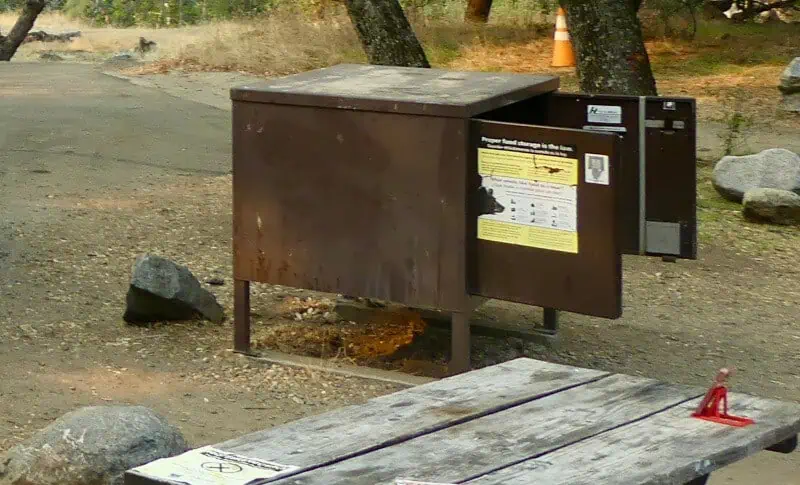
- Selecting the Right Container: Choose a bear-proof container that is certified and tested to withstand bear attempts to open it. The container should be large enough to hold all your food and scented items.
- Proper Usage: Ensure the container is properly sealed and locked at all times when not in use.
- Storing Containers: Place bear-proof containers a safe distance away from your sleeping area. They should be positioned so that they cannot easily be rolled or knocked down a hill.
- Keeping Containers Clean: Avoid leaving any food residues or fingerprints on the outside of the container, as these can attract bears.
- Accessibility: Bear-proof containers should be accessible during the day but securely closed and stored away at night or when the campsite is unattended.
- Rental Options: In some camping areas, bear-proof containers are available for rent. This can be a convenient option for those who do not own a container.
By using bear-proof containers effectively, you can significantly reduce the risk of bears being attracted to your campsite due to food odors.
13. Avoiding Attractants
Minimizing attractants is key in bear country. This tip offers strategies for reducing and managing scents that might attract bears, including food odors and scented personal items.
- Minimize Scented Items: Reduce the use of scented items such as lotions, soaps, perfumes, and scented wipes while camping. Bears have a keen sense of smell and can be attracted to these items.
- Proper Storage: Store all scented items, including toiletries and garbage, in bear-proof containers or hang them as you would with food.
- Food Preparation: When cooking, choose foods and cooking methods that minimize strong odors.
- Clean Cooking Gear Thoroughly: Ensure all cooking gear is cleaned immediately after use, leaving no residue or odor.
- Dispose of Waste Water Properly: Dispose of dishwater and any other waste water by scattering it at least 100 yards away from your campsite.
- Avoiding Spills: Be careful to avoid spilling food or beverages on your clothing or around the campsite.
- Securely Pack and Dispose of Feminine Products: Used feminine hygiene products should be securely packed and disposed of in the same manner as food waste, as they can attract bears.
By diligently managing attractants, you can significantly reduce the likelihood of a bear visiting your campsite.
14. Sleeping Safely in Bear Country
Ensuring safety while sleeping in bear country is paramount. This tip provides guidelines on selecting a tent site, managing food and scents, and preparing for nighttime bear encounters.
- Choose a Safe Tent Site: Your tent should be located at least 100 yards away from cooking and food storage areas. Look for a spot that is free from signs of bear activity.
- Avoid Food in the Tent: Never store food, beverages, or scented items in your tent. Even items like toothpaste or scented lip balms should be stored with your food supply.
- Clean Sleeping Gear: Ensure that your sleeping gear, including sleeping bags and pads, is free of food odors. Avoid wearing clothes in your sleeping bag that you cooked in.
- Bear Spray Accessibility: Keep bear spray within reach while you are in your tent. Make sure you know how to use it, even in the dark.
- Noise-Making Devices: Have a whistle or an air horn within reach to scare off a bear that may enter your campsite.
- Emergency Exit Plan: Be familiar with the quickest and safest way to exit your tent in case of a bear encounter at night.
By following these guidelines, you can minimize the risk of bear encounters during the night and ensure a safer sleep while camping in bear country.
15. Leave No Trace Principles
Adhering to Leave No Trace principles is essential in bear country to protect the environment and wildlife. This tip covers the core principles of outdoor ethics, emphasizing their importance in bear habitats.
- Plan Ahead and Prepare: Research the area you’ll be visiting. Understand bear activity and regulations for the area to minimize your impact.
- Travel and Camp on Durable Surfaces: Stick to established trails and campsites to reduce your footprint.
- Dispose of Waste Properly: Pack out all trash and leftover food. Follow guidelines for human waste disposal in bear country.
- Leave What You Find: Do not disturb wildlife or natural habitats. Avoid altering campsite areas.
- Minimize Campfire Impacts: Use a camp stove for cooking rather than a fire. If you must build a fire, use existing fire rings and keep fires small.
- Respect Wildlife: Observe wildlife from a distance. Do not follow, approach, or feed animals.
- Be Considerate of Other Visitors: Respect other visitors and protect the quality of their experience. Keep noise levels down and control pets at all times.
Adhering to Leave No Trace principles is crucial in preserving the natural environment and ensuring that future generations can enjoy the wilderness responsibly and safely.
Stay Safe
Camping in bear country can be a rewarding and memorable experience when done responsibly. By following these fifteen safety tips, you can significantly reduce the risks associated with bear encounters and contribute to the preservation of wildlife. Remember, the key to a successful camping trip in bear habitats lies in preparation, awareness, and respect for the environment. Armed with this knowledge, you are now better equipped to enjoy the beauty of bear country safely and responsibly, ensuring a harmonious coexistence with the majestic wildlife that resides there.

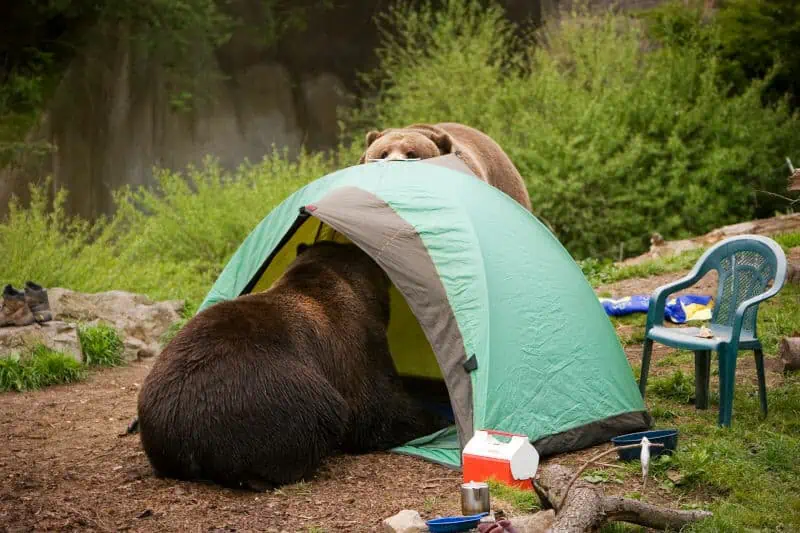
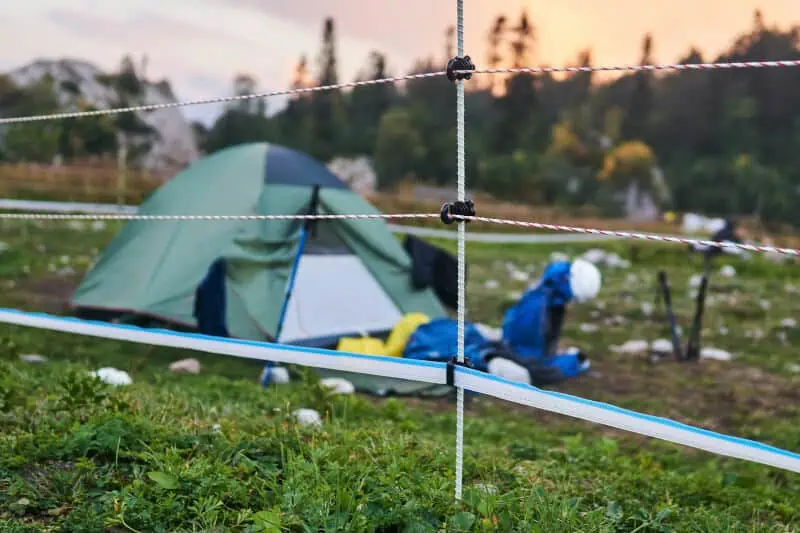
 Use Bear-resistant Containers: Store all food, beverages, and scented items in bear-resistant containers. These containers should be locked and placed away from your sleeping area.
Use Bear-resistant Containers: Store all food, beverages, and scented items in bear-resistant containers. These containers should be locked and placed away from your sleeping area.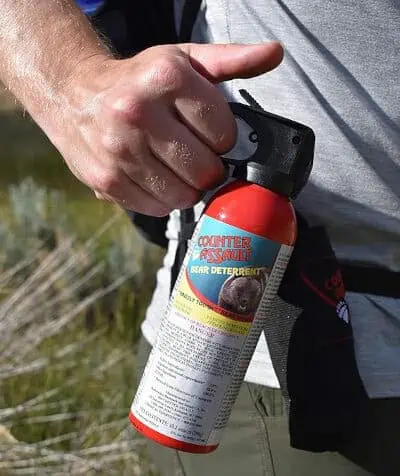 Bear Spray: Carry bear spray and know how to use it. It should be readily accessible, not buried in your backpack.
Bear Spray: Carry bear spray and know how to use it. It should be readily accessible, not buried in your backpack.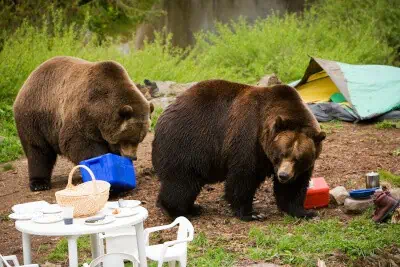 Cooking Location: Set up your cooking area at least 100 yards from your sleeping area. Choose a spot downwind from your tent to ensure food odors drift away from where you sleep.
Cooking Location: Set up your cooking area at least 100 yards from your sleeping area. Choose a spot downwind from your tent to ensure food odors drift away from where you sleep.



